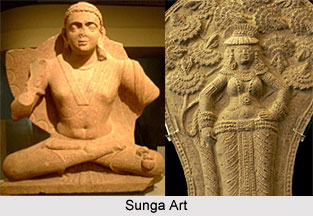 The Sunga art of Mathura, best expressed in its sculptures, belong to the pure old tradition of Bharhut and Sanchi. By the time of the Sungas and the Saka-Ksatrapas, Mathura was already famous as an art centre. During this age, the so-called `God made` Vodra Stupa of Jainas was standing in its full glory on the present Kankali Tils. Colossal figures of Boddhisattavas, Amohini stone, railing pillars, lion capital and a few architectural fragments are some of the acquisitions of this period. A few of the sculptures portray Jataka tales.
The Sunga art of Mathura, best expressed in its sculptures, belong to the pure old tradition of Bharhut and Sanchi. By the time of the Sungas and the Saka-Ksatrapas, Mathura was already famous as an art centre. During this age, the so-called `God made` Vodra Stupa of Jainas was standing in its full glory on the present Kankali Tils. Colossal figures of Boddhisattavas, Amohini stone, railing pillars, lion capital and a few architectural fragments are some of the acquisitions of this period. A few of the sculptures portray Jataka tales.
Some of the important features of Sunga art of Mathura are as follows:
1. The sculpture is not in bold relief.
2. Both the male and female figures are adorned with a large number of ornaments.
3. Drapery is somewhat heavy and not light as is the case with the sculptures of later periods.
4. No efforts seem to have been made for expressing emotions and abstract feelings like peace, serenity, temptation, surprise, sobriety etc.
5. Normally, the eyeballs are conspicuous by their absence.
6. Female figures are seen decorating their headgears with wreaths and garlands, beads and pieces of costly cloth.
7. The males appear with a special type of fluffy turbans generally decorated with a crest above. A lock of hair frequently appears out of the turban.
8. Absence of the figure of Gautama Buddha is most noteworthy in Sunga art. Lord has been represented here by different symbols, such as Stupa, three-thronged symbol (Triratna), diamond throne (Vajrasana), turban (Usnisa), begging bowl (Bhiskhsha Patra), the sacred tree (Bodhi tree), wheel of Law (Dharma Chakra) and others.
The sculptures of the Sunga period hailing from Mathura indicate that along with others, images of Vaishnava and Shaiva sects were also coming into vogue. In this connection, images of Balaram, Shivalinga etc have been found. Some Sunga works show the influence of floral scroll patterns and Hellenistic elements as far as rendering of the fold of dresses are concerned. Sunga art reflects more of the mind, culture, tradition and ideology. During Sunga period, stone replaced wood in the railings and the gateways of the Buddhist stupas. Bharhut stupa is filled with sculptures - apart from floral designs, animal, figures, Yakshas and human figures. This period witnessed the increasing use of symbols and human figures in architecture. There was an increase in the construction of rock-cut temple for example the Chaitya Hall.



